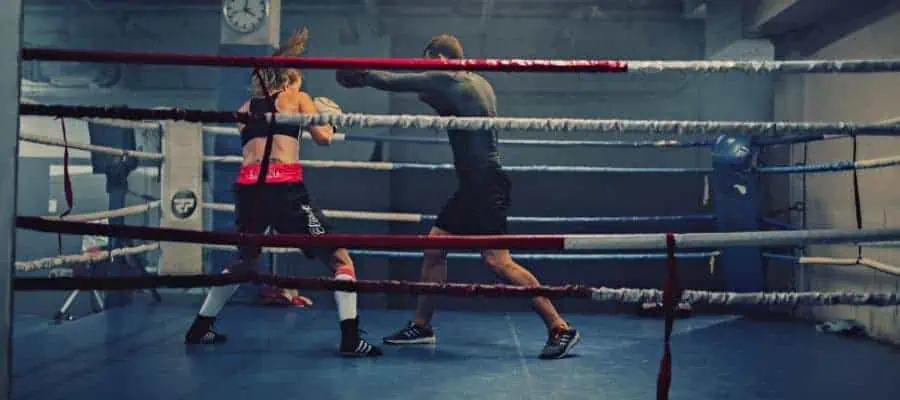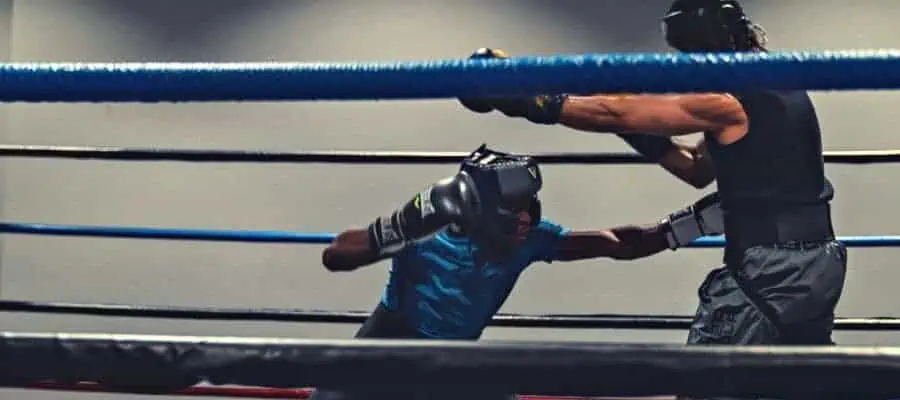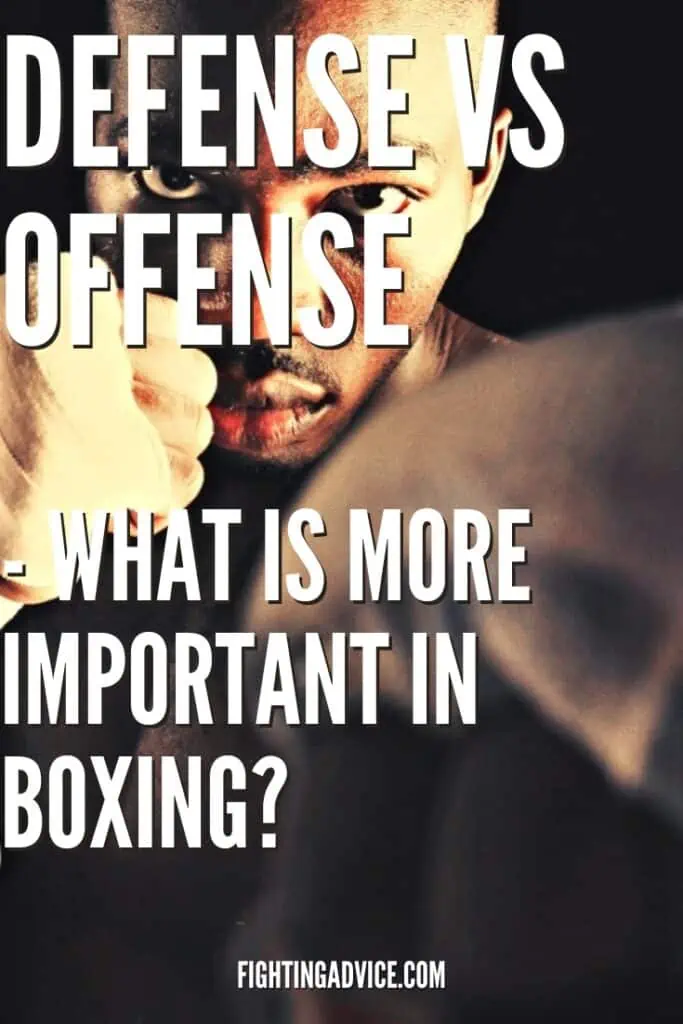As a boxer, one often ponders the optimal approach: being an aggressive fighter who launches constant attacks or adopting a defensive stance, countering the opponent’s moves. The delicate balance between relentless offense and strategic defense is a captivating aspect of the sport, leaving the choice between these two styles a thoughtful consideration for every boxer.
So, is defense or offense more important in boxing? In general, boxers need a combination of offensive and defensive strategies to thrive in the ring. By exploring various techniques, remaining adaptable during fights, and consistently honing skills through practice and training, one can enhance overall performance and increase chances of success.
Afterward, many fighters may find themselves delving deeper into this topic, asking insightful questions such as: “What is the basis for this dual approach, and why is it necessary to use both offensive and defensive strategies in combat?”. Keep reading to better understand the strategic logic that determines success in the ring.
Why Do You Need Both Offense and Defense?

Both offense and defense are crucial for a fighter’s success. A boxer must have a well-rounded skill set that includes offensive and defensive techniques. While offense can help a fighter score points and win matches, a good defense is equally important as it helps a fighter avoid getting hit, conserve energy, and stay in the fight longer. The importance of offense or defense will depend on the individual fighter’s style, strengths, and weaknesses.
Role of Defense in Boxing
Defense is a crucial aspect of boxing, and it plays a significant role in determining the outcome of a fight. The primary objective of defense in boxing is to avoid or block incoming punches. This will minimize the amount of damage inflicted by the opponent. There are several techniques used in boxing for defensive purposes:
Footwork
Footwork is a critical aspect of boxing defense. This allows boxers to move in and out of range quickly and efficiently, evade punches, and set up counterattacks. Tips for using footwork to improve defensive skills include an array of techniques, such as:
- Staying light on your feet
- The use of generating angles on your opponent
- Create and maintain distance
- The use of pivoting on your lead foot to create a new opening
Good footwork involves controlling your movements by positioning yourself to maximize both defensive and offensive options.
Head Movement
Head movement is a crucial skill in boxing that involves moving the head to avoid punches and create openings for counterattacks. There are different techniques for head movement, such as:
- Slipping
- Bobbing and weaving
- Pullback
- Shoulder roll
Effective head movement requires good timing, coordination, footwork, and technique.
Blocking
This defensive technique is used in boxing to protect oneself from incoming punches. It involves using arms, hands, and sometimes shoulders to absorb or deflect the impact of a punch. There are different types of blocks, including:
- High Guard
- Low Guard
- Long Guard
- Cross-Arm block
Blocking should always be accompanied by footwork and head movement to avoid being hit with follow-up punches.
Parrying
This defensive technique in boxing deflects an opponent’s punches. It involves using your hands and arms to redirect the incoming punch away from your body. Also, parrying requires good reflexes and timing. It should be combined with other defensive moves like slipping and weaving.
It can be used for various punches and set up potential counterattacks, but in most situations, it must be used as a defense technique. Keeping your guard up is important when using parrying as a defensive move.
Clinching
This technique is used in boxing to disrupt an opponent’s rhythm or create a break in the action. It involves grabbing onto your opponent’s body. This is typically around the neck or over the arms and holding on tightly to prevent them from punching effectively.
Clinching can be used as a defensive tactic to avoid being hit or as a tactic to wear down your opponent. However, excessive clenching can result in warnings or point deductions from the referee. Clinching is often used in combination with other techniques like setting up an uppercut or moving an opponent toward the ropes or corners of the ring.
Role of Offense in Boxing
The offense is an equally important aspect of boxing as a defense. A boxer’s offensive skills encompass punching power, speed, accuracy, and combinations. It can make the difference between winning and losing a fight.
Effective offense allows a boxer to control the pace and rhythm of the fight. Where they dictate the distance between themselves and their opponent and keep their opponent on the defensive. Here are some reasons why offense is important in boxing:
Scoring Points
In boxing, points are awarded for landing clean punches on the opponent’s head or body. In professional boxing, landing effective punches that hurt the opponent can earn a boxer the respect of the judges and the audience.
Wearing Down the Opponent
A relentless offensive attack can gradually weaken an opponent’s stamina and resilience. Thus making them more susceptible to punches and less likely to mount their own attacks.
Capitalizing on Opportunities
Effective offense allows a boxer to seize opportunities to exploit an opponent’s weaknesses. This is where they can land effective and destructive punches that may result in a knockout.
Psychological Advantage
A solid offensive game can put psychological pressure on the opponent. Thus making them more hesitant and defensive, which can create further openings for the attacking boxer.
Strategies Between Offense and Defense

In Boxing, success is not solely determined by a fighter’s ability to attack their opponent. Rather, a balance between offense and defense is crucial to achieving victory in the ring. Fighters must be skilled in both strategies, requiring a combination of quick reflexes, strong punches, effective footwork for the offense, and techniques such as blocking, slipping, and parrying punches for defense. It is a fundamental aspect of the sport that separates successful fighters from the rest.
A good defense in boxing can minimize damage. By avoiding or blocking punches, they can frustrate their opponent by making it difficult for them to land punches, which may open their opponent up for a counter. This builds confidence by allowing the boxer to take more offensive risks. Additionally, they may tire out the opponent and negate their ability to score points.
Having a powerful offensive game in boxing can bring several advantages to a boxer. This includes the ability to score points and impress judges on the scorecards. Offense can keep opponents on the defensive and minimize their ability to score.
A relentless number of attacks will demoralize the confidence of their opponent. A good offense can potentially end the fight early. It can also create an exciting and entertaining fight. So, the audience’s reaction can influence the judges’ scoring if the fight leads to a decision.
Finding the Right Balance in Boxing
Finding the right balance between offense and defense is critical to success. A strong offense can provide advantages, but a boxer can become vulnerable to counterattacks and potential knockouts if neglected.
To strike a balance, boxers should prioritize developing their defensive skills, such as footwork, head movement, and blocking, to complement their offensive skills. A boxer can become more versatile and adaptable in the ring by mastering both offensive and defensive techniques.
Boxers should also be able to read their opponents and adjust their strategy accordingly. If an opponent has a strong offense, a boxer may need to focus more on defense and counter-punching. Conversely, suppose an opponent has a weak defense. In that case, a boxer can take advantage of this by being more aggressive and attacking.
Finding the right balance between offense and defense in boxing requires practice. This is done through experience and learning to adapt to different opponents and situations. Boxers who can effectively balance offense and defense will have a better chance of achieving success in boxing.
Is Offense the Best Defense in Boxing?

Fighters can use various tactics and strategies to win a match. One common saying in the sport is, “The Best Defense is A Good Offense.” This implies that being aggressive and constantly attacking your opponent can be an effective way to defend yourself.
This is done by placing your opponent on the defensive and potentially winning the fight. However, some other techniques and approaches can be used to succeed in boxing. The offense’s effectiveness as a defense may depend on the individual fighter, the opponent, and their fighting style.
Offensive Styles in Boxing
Boxing is a sport that values finesse and strategy. A very offensive fighter will overwhelm their opponent with their offensive capabilities. There are several offensive styles in boxing. They can encompass power, volume, unpredictability, unconventional means, technical prowess, and counter-attacking ability.
Out-Fighter
An out-fighter style is a fighter who specializes in maintaining distance from their opponent by using their reach to land punches from the outside. Out-fighters typically have a longer reach than their opponents and use jabs and straight punches to keep them at bay.
They also use footwork to move around the ring and avoid being trapped in the corner. Out-fighters are often more effective against brawlers or fighters who prefer to fight on the inside. However, out-fighters can be vulnerable to pressure fighters who can get past their reach and land punches on the inside.
In-Fighter
In boxing, a type of fighter specializes in fighting at close range and infighting. In-fighters typically have a shorter reach than their opponents. They use hooks, uppercuts, and body shots to attack their opponents from the inside. They often bob and weave to avoid punches while moving in and then use their head movement and footwork to stay close to their opponents.
In-fighters are often more effective against out-fighters or fighters who prefer to fight from the outside. In-fighters may be vulnerable to taller opponents with longer reach who can keep them at bay and prevent them from getting on the inside.
Brawler
This type of fighter prefers to engage in close-range fighting, using power to overwhelm their opponents. Brawlers often rely on brute strength and aggressive tactics to defeat opponents. They make use of heavy-handed and destructive punches.
They tend to throw looping hooks and wide punches and may need better footwork or defensive skills. Brawlers are often effective against out-fighters who prefer to fight from a distance. They can struggle against more technical fighters who can evade and counter their attacks.
Boxer-Puncher
A boxer-puncher in boxing is a type of fighter who combines the skills of an out-fighter and a brawler. Boxer punchers have a well-rounded skill set. They can fight from the outside using their reach, footwork, and jabs. They also can fight at close range with hooks, uppercuts, and body shots.
They are often strong, powerful fighters who can knock out their opponents and have the technical skills to outbox them if needed. Boxer punchers can adapt their fighting style to the strengths and weaknesses of their opponents. Thus making them versatile and unpredictable fighters in the ring.
Counterpuncher
This boxing style relies on defensive techniques and counterattacks to land punches. Counterpunchers typically wait for their opponents to initiate an attack. They then use their superior timing and footwork to evade the punch and land a counterpunch. They may use feints and footwork to lure their opponents into throwing a punch that can be countered.
Counterpunchers often have good defensive skills like slipping, rolling, and parrying. Which allows them to avoid punches and set up their own counterattacks. They can be effective against aggressive brawlers and fighters who apply forward pressure. Though may struggle against out-fighters who can maintain distance and avoid being countered.
Swarmer
A swarmer relies on overwhelming their opponents with a high volume of punches. They often throw punches in bunches from close to mid-range. Swarmers tend to move forward aggressively and use their footwork to get on the inside of their opponents. This is where they can land hooks, uppercuts, and body shots. They often have good hand speed and power and can wear down their opponents throughout a fight.
Swarmers tend to have a high work rate and may need better defensive skills. They rely instead on their ability to outwork and outmuscle their opponents. They can be effective against out-fighters who struggle with pressure and close-range fighting. However, may struggle against more technical fighters who can counter their attacks.
Southpaw
These fighters are often called “Lefties” or “Southies” because the majority of boxers are right-handed. When facing a southpaw, they present a challenge to their opponents who are not used to fighting against left-handed fighters.
Southpaws can have an advantage in the ring due to their unorthodox stance and the different angles of attack that they can use. However, they may also have weaknesses in their defense that can be exploited by opponents who are familiar with their style.
Switch-Hitter
In boxing, this fighter can switch between fighting in an orthodox stance and a southpaw stance during a fight. Switch hitters can confuse their opponents by changing their stance and attacking from different angles. Thus making it more difficult for their opponents to defend against their punches.
They are often skilled boxers who have trained extensively in both stances. They can use their footwork and hand speed to transition seamlessly between stances. Switch hitters can also adapt their fighting style to the strengths and weaknesses of their opponents. This makes for versatile and unpredictable fighters in the ring.
Slugger
This type of fighter relies on their power and aggression to win fights. Sluggers often throw powerful punches, such as hooks and uppercuts, intending to knock out their opponents. They tend to move forward aggressively and use their strength to overwhelm their opponents with a high volume of punches. Sluggers may have poor technical skills, footwork, or defense.
Their power, aggression, and durability make up for this deficiency. They can be effective against opponents who are not used to fighting such an aggressive opponent. They may struggle against more technical fighters who can evade and counter their attacks.
Technician
A boxing technician is a fighter who relies on their technical skills and ring IQ to outsmart their opponents. Technicians often have excellent footwork and defensive skills. They can maintain distance and control the pace of the fight. They tend to be highly disciplined and strategic in their approach to boxing.
They use jabs, feints, and footwork to set up their punches and avoid their opponents’ attacks. Technicians can adapt their fighting style to the strengths and weaknesses of their opponents. Making them difficult to predict in the ring. They may not have the power or aggression of a slugger, but they can make up for it with their precision, fight IQ, and technical skills.
Importance of Understanding Different Offensive Styles
Understanding different offensive styles in boxing is important for effective game planning. This improves defense, adaptability, and technical knowledge of the sport. Recognizing the intricacies of different styles of offense can highlight exploits in their opponent’s style. Additionally, it enables boxers to become more versatile and less predictable in the ring.
Conclusion
Boxing is a sport that requires a balance between offense and defense. A strong offense can help a boxer secure a victory, but a solid defense can prevent them from getting hit and losing points. Ultimately, the answer to which one is more important depends on the boxer’s personal style, strengths, and weaknesses. A well-rounded fighter must master both aspects to become a champion in the sport of boxing. Therefore, instead of focusing on one over the other, boxers must strive to perfect their skills in both offense and defense to succeed in the ring.
If this article was helpful to you, don’t forget to add it to your Pinterest board.

Recent Posts
What is Manachai's Fighting Style? Unveiling Muay Thai Mastery
Manachai, a celebrated figure in the Muay Thai world, has captivated audiences with his exemplary martial prowess. Hailing from the heartlands of Thailand, his name is synonymous with the art of...
What Was Chamuekpet Hapalang's Fighting Style? Unveiling Techniques
Chamuekpet Hapalang was a renowned figure in the world of Muay Thai (record 200-48-2), embodying a fusion of Muay Bouk and Muay Khao styles. Originating from Thailand, the art of Muay Thai is known...
